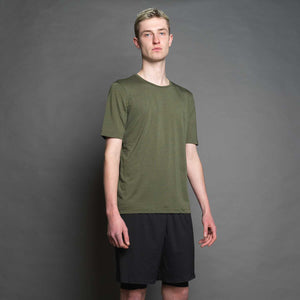ashmei uses Merino wool across the majority of our products. Helping us produce sustainable performance clothing for cycling and running, it’s a renewable material that outclasses anything else available. Highly breathable, insulating, and able to retain warmth across a range of conditions, along with its anti-odour qualities these properties are the result of millennia of natural evolution.
Warm when it’s cold and cool when it’s warm, unlike synthetic materials which release microplastics into the environment, once retired garments made of Merino are also biodegradable. But how is it that something as traditional as wool still outperforms the best machine-made alternatives when running or cycling?

No ordinary sheep
Likely originating in Morocco before being introduced to Europe, Merino sheep have long been regarded as having the softest and highest quality wool. Crucial to the economic development of medieval Spain, by the 19th century, New Zealand and Australia had become the world’s largest producers.
Today ashmei sources its Woolmark-certified Merino directly from Australia. Coming from sheep that graze outside year-round, their annual haircut yields a fleece weighing around 4.5 kilograms per animal.
Making it a completely sustainable product, each strand is about one-fifth finer than a human hair. Allowing Merino to be woven into materials softer than cashmere and smoother than silk, the structure of each fibre also imparts a range of other benefits for its wearer.
Merino Close Up
Under a microscope, it’s possible to see the unique scaled structure that’s responsible for Merino’s incredible properties. Chief among these is its ability to simultaneously attract and repel water.
Split between the interior and exterior of the fibre, unlike cotton which will quickly wet through, the outer surface of Merino-based clothing instead repels water. At the same time, its absorbent core means it can hold a third of its weight in moisture vapour without feeling wet or getting cold.
When running or cycling, Merino allows our clothing to perform consistently across a huge range of conditions. Actively pulling sweat from the wearer and highly breathable, it’s also the reason wool garments remain warm even when wet.
This ability to manage moisture reinforces Merino’s inherent quality as an insulator. Full of hollow spaces, its internal structure holds onto warm air, while the weave of fabrics made from its slimline fibres are equally able to create a stable temperature around the wearer.
This semi-permeable surface has further major benefit; it allows Merino to trap odour causing bacteria, keeping the garment and its wearer fresher until it can be washed. Something not yet well-replicated by synthetic materials like polyester, it’s the reason clothing made of wool smells better and requires less frequent washing.

Making with Merino
It’s these performance characteristics that first drew ashmei to the material. A natural choice that outshines petrochemical-based alternatives when it comes to drying time, odour control, and insulation, we’ve since worked hard to popularise its use for running and cycling apparel.
Integral to our range from its inception, we now use it in everything from our base layers, where it forms the main material, to our jackets, where it provides targeted insulation.
But as designers and technicians, we’ve not been content to simply piggyback on its inherent natural properties.
Already elastic, the weave of our fabrics further increases the wool's flexibility when applied to our garments. At the same time, innovations like our Merino + Carbon fabric have seen us add silica, allowing our Merino to convert liquid into vapour up to ten times faster than conventional alternatives.
Reducing the strain on cyclists and runners caused by having to maintain a steady temperature, it’s the only fabric technology ever proven to increase athlete performance - a fact verified by the International Journal of Sports Medicine.
Unlike when using oil-derived products, working with the producers of our Merino also allows us to push for higher environmental standards along with improved welfare for the sheep.
Already informed by millions of years of natural selection, it’s nice to think that we’re still able to add a little something too.



